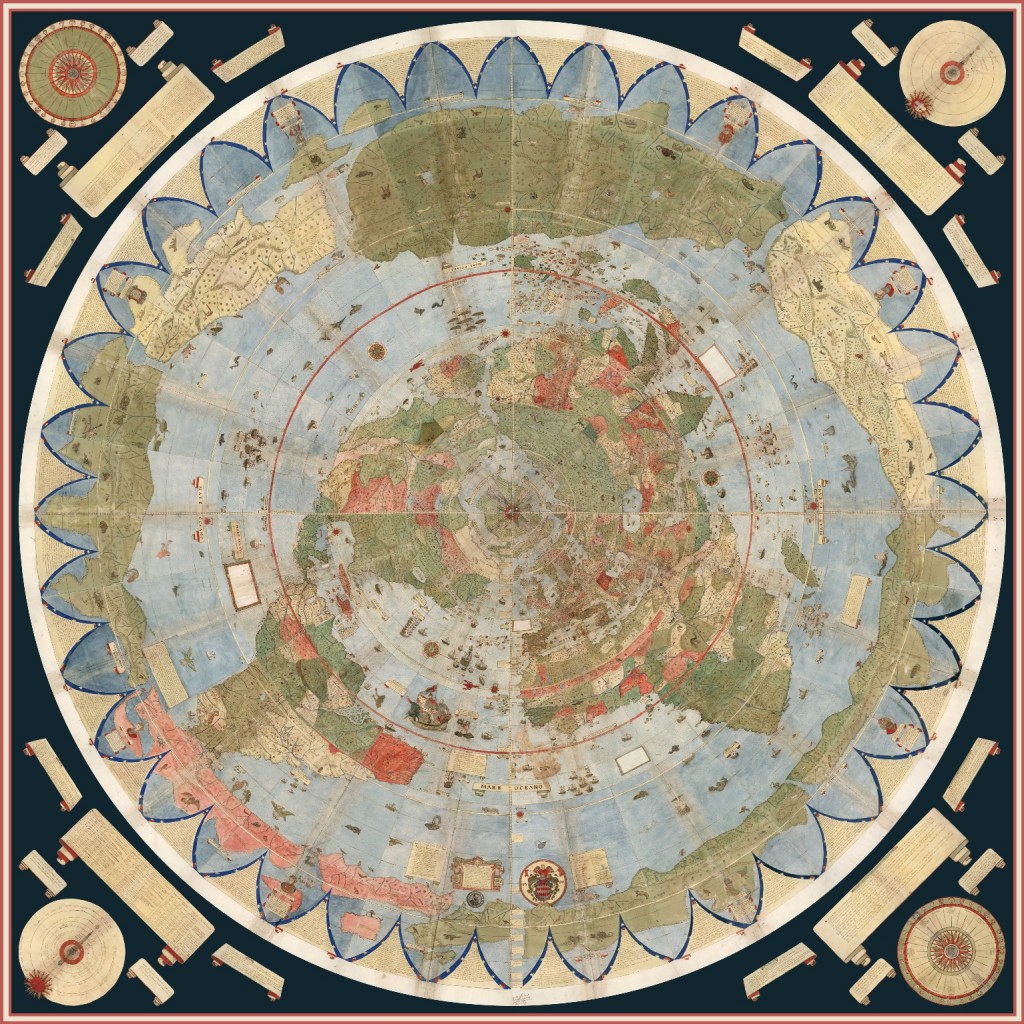An extraordinary 60 sheet manuscript world map made in 1587 by Urbano Monte has been added to the David Rumsey Map Collection at Stanford University. At 10 foot square, this map or planisphere is the largest known early map of the world. It was hand drawn by Monte in Milan, Italy, and only one other manuscript copy exists. The digitally joined 60 sheet map image below is the first time the map Monte made has been seen as one unified map – as Monte intended – in the 430 years since it was created. See all the individual sheets here.
Monte’s map reminds us of why historical maps are so important as primary resources: the north polar azimuthal projection of his planisphere uses the advanced scientific ideas of his time; the artistry in drawing and decorating the map embodies design at the highest level; and the view of the world then gives us a deep historical resource with the listing of places, the shape of spaces, and the commentary interwoven into the map. Science, art, and history all in one document. Until now, Monte’s manuscript map was seen as a series of 60 individual sheets. The only assembled version is the small single page key sheet of the series. Now that we have joined all 60 sheets digitally (accomplished with great skill by Brandon Rumsey), we can appreciate in a new way the extraordinary accomplishment that Monte made. The assembled map, just over 10 feet in diameter, is one of the largest—if not the largest—world maps made in the 16th century. The degree of detail and decoration is stunning and the entire production is surely unique in the history of cartographic representation.
Monte made his map to serve not only as a geographical tool but also to show climate, customs, length of day, distances within regions – in other words, to create a universal scientific planisphere. In his dedication on Tavola XL he specifies how to arrange the sheets of the planisphere and makes it explicit that the whole map was to be stuck on a wooden panel 5 and a half brachia square (about ten feet) so that it could be revolved around a central pivot or pin through the north pole. This was never done, but now we can do it virtually – Monte’s 60 sheet world map digitally assembled into a 10 foot planisphere:
Monte’s depiction of Japan is advanced for the time, probably drawing on information provided to him by the Japanese Embassy to Milan and Italy in 1585.
In 1589, two years after the map was completed but perhaps still being revised, Monte updated his portrait at age 43 with a new circular image pasted on top of the earlier one, now showing his age to be 45. The new portrait is hinged and can be lifted up as illustrated below.
The 6 images below show how the 60 gore sheets and 4 corner sheets were progressively joined to create the final complete 10 foot planisphere. The 1st ring of 4 sheets was joined (making sheets 1-4), then the 1st ring was added to the 2nd ring of 8 sheets (making sheets 1-12), then the 1st and 2nd rings were added to the 3rd ring of 12 sheets (making sheets 1-24), then the 1st, 2nd, and 3rd rings were added to the 4th ring of 18 sheets (making sheets 1-42), then the 1st through 4th rings were added to the 5th ring of 18 sheets (making sheets 1-60), and finally those 5 rings were added to the 4 corner sheets and labels making the complete map.
When we georeference Monte’s map and then re-project it into Mercator projection we immediately understand why he used the north polar projection instead of Mercator’s: Monte wanted to show the entire earth as close as possible to a three-dimensional sphere using a two-dimensional surface. His projection does just that, notwithstanding the distortions around the south pole. Those same distortions exist in the Mercator’s world map, and by their outsized prominence on Monte’s map they gave him a vast area to indulge in all the speculations about Antarctica that proliferated in geographical descriptions in the 16th century. While Mercator’s projection became standard in years to come due to its ability to accurately measure distance and bearing, Monte’s polar projection gave a better view of the relationships of the continents and oceans. In the 20th century air age, the polar projection returned as a favored way to show the earth. Monte would have been pleased to see a modern version of his map used in the official emblem of the United Nations. Below is Monte’s map georeferenced and re-projected as Plate Caree or Geographic. In this form it can be placed in Google Earth.
Monte’s planisphere accompanies a multi volume geographical treatise on the world and cosmology. It is hoped that further research will better join the text in the treatise to the text and geographical descriptions on the map itself. It will be of great interest to discover the sources of Monte’s geographical work and how he configured that information to create his own unique view of the world in his remarkable map.


